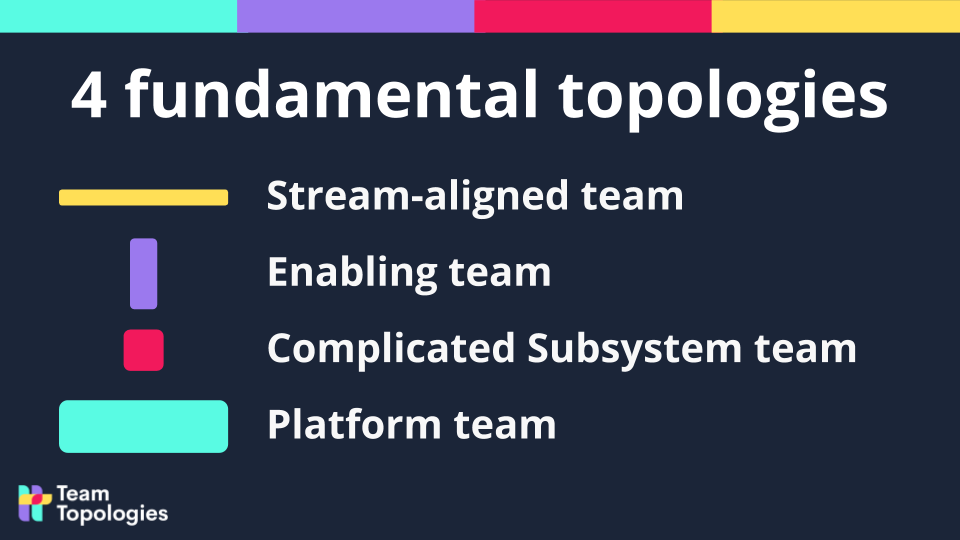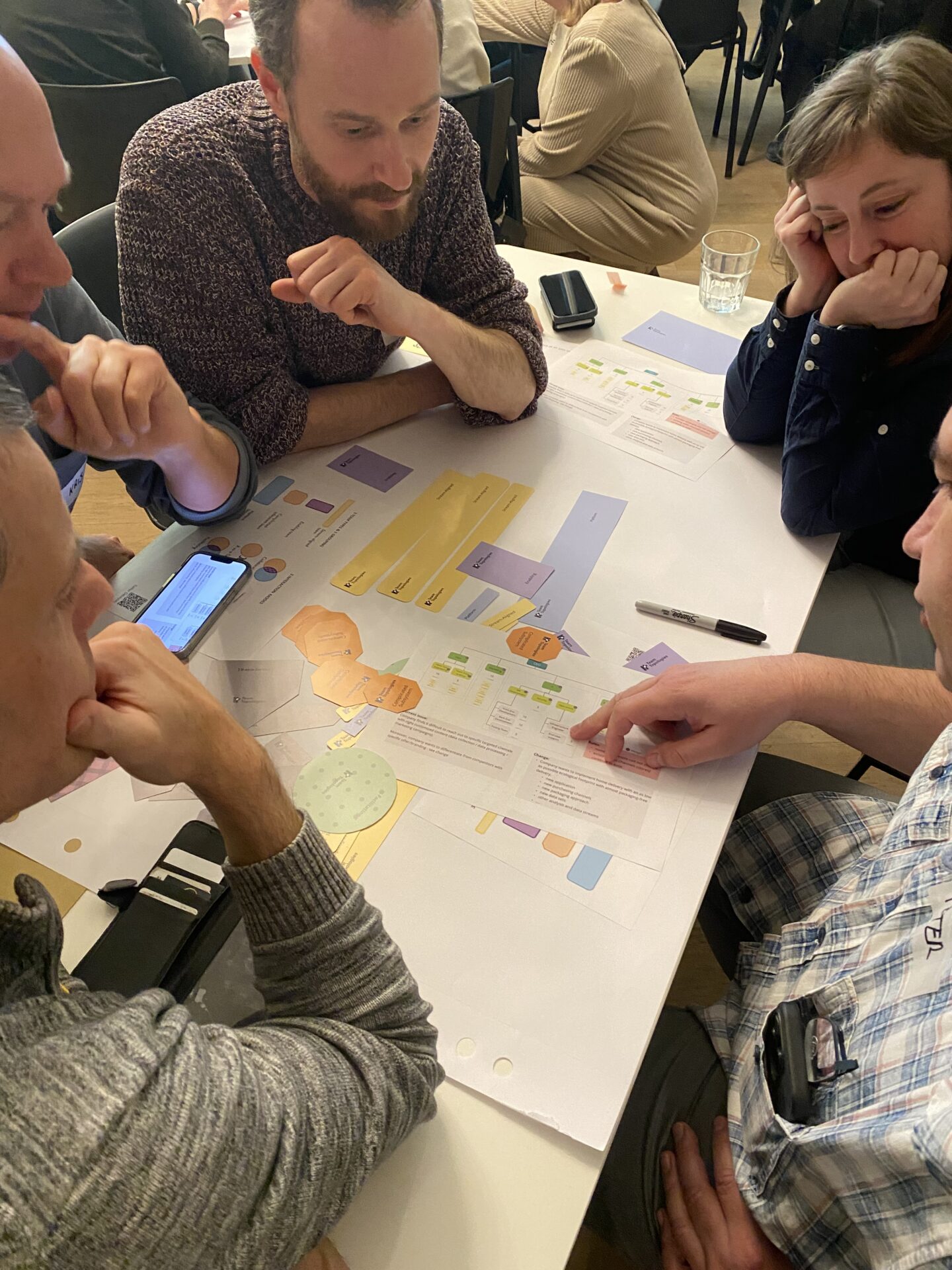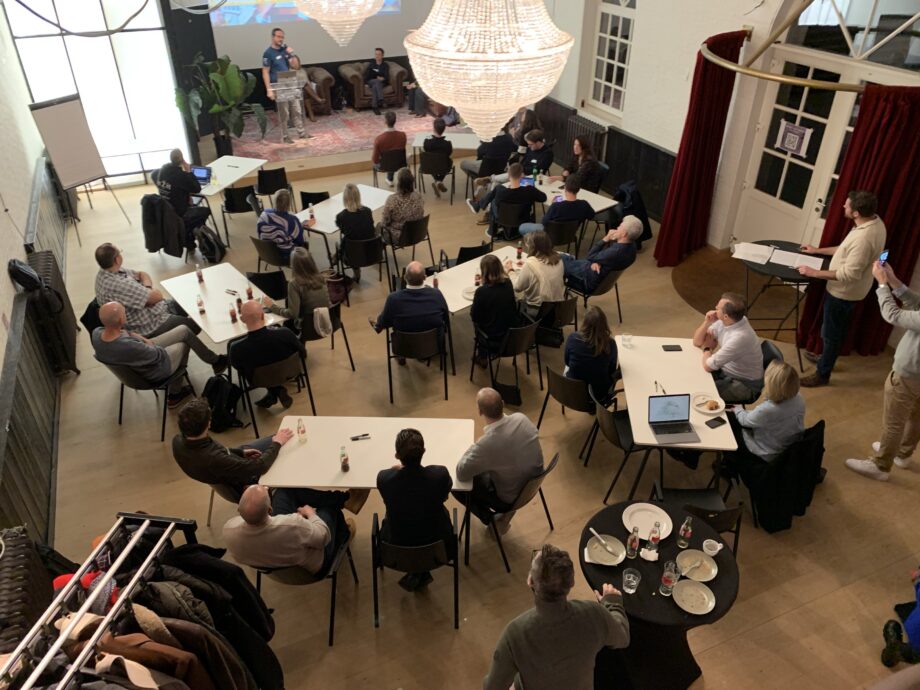In the last Agile Kitchen of 2023, we talked about Team Topologies! The session was led by Esther Dekeyser and Erica Engelen, both Business Agility Coach at Devoteam, and Stef Cuisinier, organizational Coach, Trainer & Advisor at reBoot.
After a short theoretical recap of Team Topologies, we got to work with a simulation, where elements like organizational structure, people’s cognitive load, Conway’s law and organizational sensing played a role.
We’ll take you through it with this recap!
What is “Team Topologies”?
Team Topologies is a practical library of patterns for organizational design and team interactions. It’s created by Matthew Skelton and Manuel Pais, authors of the book “Team Topologies: Organizing Business and Technology Teams for fast flow”.
At iLean, we believe that Team Topologies is more than yet another approach; it’s a major step forward in organizational design. It helps you understand team patterns and interactions, and facilitates in choosing the right team patterns for your organization, also considering context and goals. By using this approach, you can organize teams in such a way that they work together more efficiently and humanely, resulting in more effective teams.
Why should you use Team Topologies in your organization?
“It sounds great, but why would I implement it?” – you might think.
Well, with Team Topologies you can unblock certain flows that are holding your teams back, like an inefficient hierarchy causing slow decision-making, teams working in silos or blocking dependencies and handovers. We will give you 4 reasons to get started with Team Topologies:
- Reduced Dependencies: Minimizing dependencies between teams can streamline flow, reducing bottlenecks and accelerating delivery.
- Enhanced Communication: Improved channels for communication and collaboration foster better understanding and smoother interactions between teams.
- Clear Responsibilities: Defined team structures help clarify roles and responsibilities, reducing confusion and improving overall effectiveness.
- Evolutionary Flexibility: The ability to evolve and adjust team structures based on feedback and changing needs ensures the organization remains responsive and adaptable over time.
Are you convinced? Let’s get started!
Getting started with unblocking flows
Following the below steps, you can elevate your team from working in a waterfall-oriented way to thinking product-focused.
- Understanding Conway’s Law
Conway’s Law suggests that the structure of an organization will be reflected in the design of its systems. This means that how teams are structured and interact, will directly impact the products and services they develop. By understanding Conway’s law, you can for example unblock a flow where teams work in silos and boost the user experience of your services or products.
- Set up a socio-technical system
While developing certain technical systems or processes, don’t forget to look at the impact on the work and the team itself. For example: a possible consequence of working with cloud as technology, might be that developers adapt to developing cloud-native only. With a socio-technical system, you focus both on social and technical aspects to build successful solutions. You let go of focusing purely on the technical expertise of people and also take into account the social dynamics of how teams interact with each other. By developing this kind of system, you acknowledge the importance of communication, empathy, knowledge sharing, and so on.
- Cognitive capacity
Consider the cognitive load and capacity of teams. Complex tasks, dependencies, and communication overhead can overwhelm teams. Team Topologies aims to distribute cognitive load effectively, ensuring teams can focus on their core responsibilities without being overburdened by unnecessary complexity. There are 3 types of cognitive load:
- Intrinsic cognitive load is associated with one specific topic or task and varies on the expertise and experience of the individual.
- Extraneous cognitive load is the mental effort you need to put in to process information. It’s about the way information or tasks are presented, and is often referred to as the “noise” that distracts you, e.g. poorly designed interfaces, unclear instructions, …
- Germane cognitive load is related to the process of learning and problem-solving. It’s the mental effort needed to process and integrate new information into long-term memory.
It’s that kind last kind of load we want to use. To avoid having a “cognitive overload”, you need to reduce the intrinsic and extraneous cognitive load, so there’s enough space for the germane one.
- Organizational sensing
The context, market, knowledge and technology keep changing, and you need to be aware of these changes and their impact. As an organization, you need to adapt and evolve your organizational structure like team structures, communication channels and workflows. Don’t be afraid to identify pain points or areas where improvements can be made. Understanding the organization’s current state is crucial in determining how Team Topologies can be implemented effectively and will help you immensely in the future.
The next step in the process is identifying team types or topologies, and determining how they communicate.
The 4 fundamental topologies
According to Team Topologies, you structure your teams based on the organization’s communication needs and the nature of its systems. Choosing the right team structure and interactions is crucial for successful agile practices.

- Stream-aligned team These teams are responsible for delivering value directly to customers. They’re aligned with specific business streams or products and work closely with stakeholders to deliver and iterate on features. This is the cornerstone of an agile organization and is typical for a cross-functional, multidisciplinary team.
- Complicated-subsystem team These teams handle more complex parts of the system that require specialized knowledge or skills. By providing expertise to other teams, they help reduce the intrinsic cognitive load of those teams and streamline the work. Beware: don’t just use these teams to attain expertise. Do it to really help other teams.
- Enabling team Enabling teams help stream-aligned teams to overcome obstacles. They provide tools, platforms and support both on a temporary and permanent basis, enabling other teams to work more efficiently. Typically, they support adopting new technologies or helping with one specific problem. Enabling teams often require special skilled people like, for example, AI or security experts.
- Platform team (or grouping) These teams offer a platform as a product, in order to reduce the cognitive load of other teams. It closely aligns with enabling teams, but platform teams focus specifically on providing platforms as a service. For example, they might work on internal tools, developing API’s, creating infrastructure or other tools to facilitate the work of other teams. They build and maintain certain “foundations” that other teams rely on.
3 ways of interaction
Next to different topologies of teams, the way they interact with each other is also essential. Choosing the correct communication modes is crucial for effective collaboration, sharing resources, and ensuring streamlined interactions between different teams within an organization, all aligned with the principles of Team Topologies
- Close Collaboration
Teams work intensively together for a short period of time and with a clear goal, and only when it’s necessary, as it implies dependencies. It involves direct and interactive communication between team members and consists of brainstorming sessions, discussions, and problem-solving activities where team members actively engage with each other. It often happens in meetings, workshops, or informal conversations.
- X-as-a-Service (XaaS)
X-as-a-Service refers to offering a self-service where the customer doesn’t need any background or information about the service. This communication mode involves one team providing a service, capability, or tool that other teams can autonomously access and use as needed. It encourages a service-oriented approach within the organization. It’s often seen with platform teams.
- Facilitating
Facilitating communication involves enabling the flow of information, knowledge, or resources between teams. Facilitators or coordination mechanisms help teams interact effectively by removing barriers, setting up frameworks, providing guidance, and ensuring smooth interactions. It is mostly used in enabling teams.

Let’s exercise
No Agile Kitchen is ever done without some serious practical exercising!
Disclaimer: Like anything agile, there isn’t a single solution, and it needs continuous evaluation and adjustment along the way. Below exercise example is one from our agile coach Frederik Vannieuwenhuyse and his group.
We’re diving into exploring various types of team structures and interaction modes for an organizational case.
We start from an organizational chart where teams are set up into departments and grouped by expertise (IT, HR, purchasing, marketing). IT is further subdivided into front-end development, back-end development, operations, etc.
The exercise aims to restructure the teams, based on a specific value stream that resonates with a customer segment. So we start by laying out different team types (beginning with identifying the value streams) and subsequently the interaction types.
In our solution, we begin with value-stream-aligned teams, and then add a platform team and gather expertise in a complicated sub-system team. We decide to avoid unnecessary close collaboration unless absolutely necessary, as it could lead to delays.
We’re pretty happy with our solution, and it’s interesting to see how all the other teams handled it. And as we mentioned: there’s not just one solution here.
So, are you all ready to revolutionize your team dynamics?
If you want to start your journey towards optimized workflows and empowered teams, get in contact!

